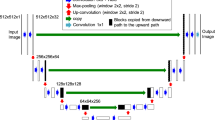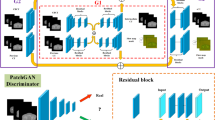Abstract
We conducted a comparative analysis of six image-to-image deep learning models for the purpose of MRI-to-CT image translation comprising resUNet, attUnet, DCGAN, pix2pixGAN with resUNet, pix2pixGAN with attUnet, and the denoising diffusion probabilistic model (DDPM). These models underwent training and assessment using the SynthRAD2023 Grand Challenge dataset. For training, 170 MRI and CT image pairs (patients) were employed, while a set of 10 patients was reserved for testing. In summary, the pix2pixGAN with resUNet achieved the hightest scores (SSIM = 0.81±0.21, MAE = 55.52±3.50, PSNR = 27.19±6.29). The DDPM displayed considerable potential in generating CT images that closely resemble real ones in terms of detail and fidelity. Nevertheless, the quality of its generated images exhibited notable fluctuations. Consequently, further refinement is necessary to stabilize its output quality.
Access this chapter
Tax calculation will be finalised at checkout
Purchases are for personal use only
Preview
Unable to display preview. Download preview PDF.
Similar content being viewed by others
References
Lyu Q,Wang G. Conversion between CT and MRI images using diffusion and score-matching models. 2022;(arXiv:2209.12104).
Kearney V, Ziemer BP, Perry A,Wang T, Chan JW, Ma L et al. Attention-aware discrimination for MR-to-CT image translation using cycle-consistent generative adversarial networks. Radiol Artif Intell. 2020;2(2):e190027.
Strittmatter A, Schad LR, Zöllner FG. Deep learning-based affine medical image registration for multimodal minimal-invasive image-guided interventions: a comparative study on generalizability. Z Med Phys. 2023;23.
Raj A, Tollens F, Hansen L, Golla AK, Schad LR, Nörenberg D et al. Deep learning-based total kidney volume segmentation in autosomal dominant polycystic kidney disease using attention, cosine loss, and sharpness aware minimization. Diagnostics. 2022;12(5):1159.
Bauer DF, Russ T, Waldkirch BI, Tönnes C, Segars WP, Schad LR et al. Generation of annotated multimodal ground truth datasets for abdominal medical image registration. Int J CARS. 2021;16(8):1277–85.
Thummerer A, Bijl E van der, Galapon A, Verhoeff JJC, Langendijk JA, Both S et al. SynthRAD 2023 grand challenge dataset: generating synthetic CT for radiotherapy. Med Phys. 2023;50(7):4664–74.
Ronneberger O, Fischer P, Brox T. U-net: convolutional networks for biomedical image segmentation. Proc MICCAI. 2015:234–41.
Oktay O, Schlemper J, Folgoc LL, Lee M, Heinrich M, Misawa K et al. Attention U-net: learning where to look for the pancreas. Medical Imaging Deep Learning. Ed. by Ginneken B van, Welling M. Vol. 1. 2018.
Cardoso MJ, Li W, Brown R, Ma N, Kerfoot E, Wang Y et al. MONAI: an open-source framework for deep learning in healthcare. 2022;(arXiv:2211.02701).
Radford A, Metz L, Chintala S.Unsupervised representation learning with deep convolutional generative Adversarial Networks. Proc ICLR. 2016.
Isola P, Zhu J, Zhou T, Efros AA. Image-to-image translation with conditional adversarial networks. Proc IEEE CVPR. Los Alamitos, CA, USA, 2017:5967–76.
Ho J, Jain A, Abbeel P. Denoising ciffusion probabilistic models. Proc IEEE. (NIPS’20). Vancouver, BC, Canada: Curran Associates Inc., 2020.
Chen Z, Zheng K, Li C, Yiwen Z. A hybrid network with multi-scale structure extraction and preservation for MR-to-CT synthesis in SynthRAD2023. SynthRAD2023. 2023.
Alain-Beaudoin A, Savard L, Bériault S. Paired MR-to-sCT translation using conditional GANs: an application to MR-guided radiotherapy. SynthRAD2023. 2023.
Author information
Authors and Affiliations
Corresponding author
Editor information
Editors and Affiliations
Rights and permissions
Copyright information
© 2024 Der/die Autor(en), exklusiv lizenziert an Springer Fachmedien Wiesbaden GmbH, ein Teil von Springer Nature
About this paper
Cite this paper
Yang, Z., Zöllner, F.G. (2024). Comparison of Deep Learning Image-to-image Models for Medical Image Translation. In: Maier, A., Deserno, T.M., Handels, H., Maier-Hein, K., Palm, C., Tolxdorff, T. (eds) Bildverarbeitung für die Medizin 2024. BVM 2024. Informatik aktuell. Springer Vieweg, Wiesbaden. https://doi.org/10.1007/978-3-658-44037-4_89
Download citation
DOI: https://doi.org/10.1007/978-3-658-44037-4_89
Published:
Publisher Name: Springer Vieweg, Wiesbaden
Print ISBN: 978-3-658-44036-7
Online ISBN: 978-3-658-44037-4
eBook Packages: Computer Science and Engineering (German Language)




